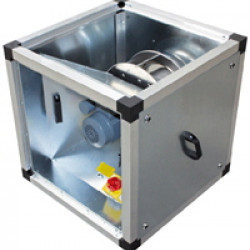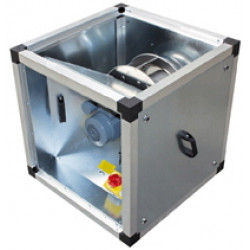
Commercial Centrifugal Box Fans
Commercial centrifugal fans are powerful and long-lasting extractor fans that are tolerant to heat and high grease levels. They offer a high level of power for their size and are able to overcome high levels of system resistance within runs of ductwork. We offer a range of compatible inverter speed controllers and can provide a pre-test and pre-wiring service for those who are unsure of the wiring configuration.
Question: What is a Box Fan?
90-Degree Backward Curved Fans
- Heat Resistance: This design allows the fan to withstand higher heat levels, prolonging its lifespan.
- Blade Design: Backward curved blades reduce particulate buildup, keeping the fan cleaner and more efficient over time.
- Balance and Efficiency: The centrifugal nature of these impellers provides better balance and increased efficiency.
Straight Through (Axial) Fans
- Motor Position: The motor is also axial, leading to higher operating temperatures.
- Cooling Mechanism: To combat the heat, these fans often feature cooling fins that help extend the motor's lifespan.
Additional Benefits of Box Fans
- Routine Maintenance: These motors are designed for easy routine maintenance, enhancing overall durability and performance.
- Exchangeable Motors: The ability to swap motors reduces servicing costs and downtime.
How Energy Efficient Are Box Fans?
Backward Curved Fans
A box fan is a versatile ventilation device that can be designed with different airflow paths, either 90 degrees or straight through (axial).
- Motor Position: The motor is positioned out of the airstream.
- Space-Saving Design: These fans are fitted axially, aligning with the ducting axis, which saves space.
- Energy Efficiency: Backward curved fans are known for their high energy efficiency. Their design allows for smoother airflow with less turbulence, which translates to lower energy consumption.
- Aerodynamic Design: The backward curved blades are aerodynamically optimized to reduce resistance and enhance the fan's performance. This efficient airflow reduces the workload on the motor, further saving energy.
- Improved Performance at High Static Pressure: These fans maintain their efficiency even at high static pressures, making them ideal for applications requiring powerful and consistent airflow.
Axial Fans
- Energy Efficiency: While axial fans can be energy efficient, they are generally less so compared to backward curved fans, especially under high static pressure conditions. Axial fans are more suited for low to medium pressure applications.
- Straight-Through Airflow: The straight-through design of axial fans is less efficient in managing airflow resistance, often requiring more power to achieve the same airflow as backward curved fans.
- Motor Cooling Requirements: Axial fans often need additional cooling mechanisms, such as fins, to manage the motor temperature, which can slightly increase energy consumption.
Conclusion
Backward curved fans typically offer superior energy efficiency compared to axial fans, particularly in applications with high static pressure. Their aerodynamic design and ability to maintain performance under demanding conditions make them a more energy-efficient choice for industrial and commercial use. Axial fans, while effective in certain scenarios, generally consume more energy to achieve the same performance level due to their less efficient airflow management and additional cooling requirements.

